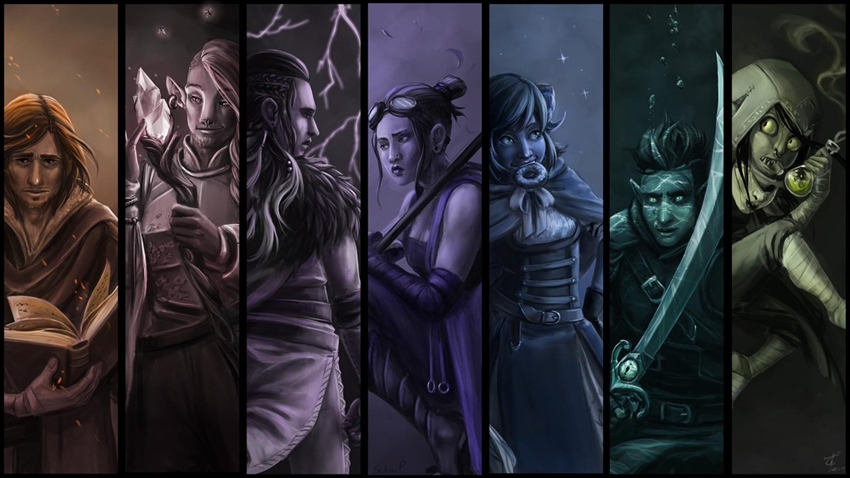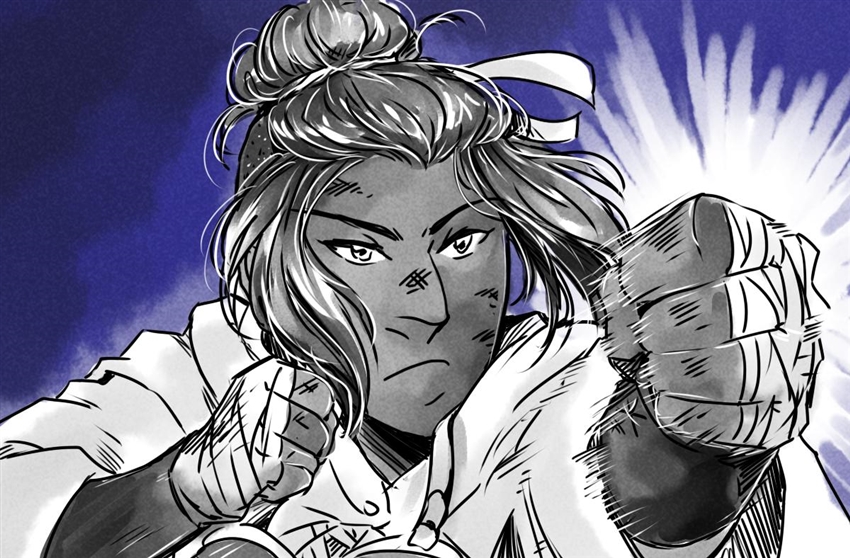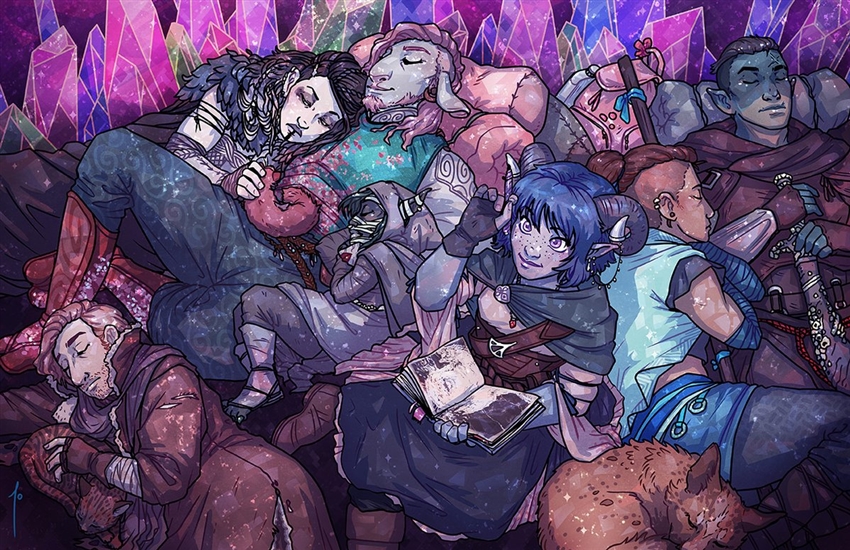This week, the Mighty Nein emerged from darkness and began a journey over a vast and inhospitable land. Danger lurks in every corner… but how much danger is too much? The Mighty Nein still have a quest to complete, and getting slammed by encounter after random encounter would grind the game to a halt. How did Matthew Mercer balance using random encounters to show the dangers of Xhorhas firsthand, while still allowing the party to advance in their quest?

Art by Sedona (@anodesu)
Episode Summary
Previously on Critical Role, the Mighty Nein traveled to Xhorhas in search of Nott’s husband, Yeza, through a seemingly endless tunnel burrowed by a purple worm bound by Kryn soldiers. They spent weeks underground, and encountered kobolds, ropers, and other monsters in their journey—including a close encounter with a civilization of fire giants with a mighty underground citadel surrounded by rivers of magma.
This week, our heroes healed their wounds and slipped past the fire giants. They traveled as quickly as they could through the endless darkness until the cavern began to wind upward. The tunnel became steep, steeper, and steeper still until they were climbing sheer rock face towards a pinpoint of light in the distance—until they emerged in the frigid air of the wastes of Xhorhas. Miles off, they saw a group of massive creatures lumbering across the landscape. The party turned to Yasha, and she simply scowled and shook her head. “It would be best to avoid those,” she muttered. “They have quite a bit of meat, but… they’re a bit of a tussle.”
Braced by mountains behind them and faced with wide open scrubland in front of them, the party advanced cautiously until they saw the Ashguard Garrison, a Dwendalian military encampment, in the distance. Last they had heard, the garrison had fallen to the Kryn armies and was currently occupied. In keeping their distance, the Mighty Nein encountered a cloaked man—and a dozen other cloaked men lurking in the bushes with arrows nocked. The first man was named Kalden, and his companions were Dwendalian scouts from Bladegarden. The Mighty Nein introduced themselves, and Kalden offered them shelter and supplies—but this moment of peace did not last long.
Their conversation was cut suddenly short when an arrow zipped through the air and buried itself deep in the chest of one of the wanderers. A group of gnolls wielding longbows rained arrows down upon the scouts, yelping and hollering as they attack. However, before the Mighty Nein could leap into action, a Kryn warrior in full armor fell upon the gnolls. He wielded unknown magic, using spells to create spectral copies of himself to strike in unison with his real blade. More Kryn warriors appeared from the shadows and began to slaughter the gnolls with their magic.
The battle became a frantic melee between four parties. The Kryn quickly routed the scouts, leaving the Mighty Nein to fight them alone, while the few remaining gnolls spread chaos across the battlefield. After the battle, the few remaining scouts burned the corpses of the dead and gave the Nein a few scant supplies before breaking off and returning to Bladegarden. The Nein left their conspicuous cart behind and began to travel eastward on foot, into Kryn territory and towards Ghor Dranas.
The Mighty Nein crossed a wide open, barren wasteland. They had no cover to hide behind, so they traveled as slowly and stealthily as they could manage, keeping watch whenever possible, and using the magical Kryn beacon to gain a Mote of Possibility at the start of every day. After several days later, as they neared the banks of the Ifilon River, Jester heard low, gravelly voices drifting over the moors. Nott heard the voices speaking Goblin, and they growled, “Quick! Grab your things and run. It’s coming!”
A massive bird, a diseased and ailing roc, swooped over the plains and nearly spotted the Mighty Nein. Fjord used a major image of a mastodon to distract the mythic beast as they hid in the grass, and as the bugbears fled to escape. The roc devoured the fleeing bugbears, but the Mighty Nein found one that was playing dead after the roc left, and interrogated him for information on how to cross the river. The bugbear told the party that he was from Asarius, the city of beasts—a city on the other side of the river, on the way to Ghor Dranas. The bugbear says that Ghor Dranas is about two weeks’ walk from Asarius, even traveling at a very fast pace. The party decided to make a stop in Asarius to find some riding animals.

Art by Elaine Tipping (@triaelf9)
Spotlight: Overland Travel
Traveling long distances on grand quests is a hallmark of fantasy. Imagine those famous shots from The Two Towers of Aragorn, Legolas, and Gimli running across Middle Earth as the heroic theme of the Fellowship swelled in the background. Recall the sight of Conan riding across the plains in search of Thulsa Doom in Conan the Barbarian. And before all of those, the sweeping shots of the grand deserts in Lawrence of Arabia.
Of course, games can’t do this. We don’t have a sweeping orchestral score and a helicopter-mounted camera delivering us a montage of gorgeous scenes from the New Zealand countryside. A fantasy film can impart the visceral feeling of weeks of travel in about 60 seconds of montage; it takes a tremendously skilled storyteller to do the same in 60 seconds of narration. And even if your DM possesses the skill to do so, it’s not necessarily a good thing to simply handwave the journey away. The point of D&D is to play together with your friends, and the players should have a chance to play during the journey, not just have the journey explained to them.
I’ve discussed ways of making overland travel interesting before, but I want to talk about a mechanical way in which characters can impact the travel experience: speed and stealth. Throughout episode 51 of Critical Role, either Matt or the rest of the cast brought up all three paces of overland travel within the D&D rules: slow, normal, and fast. Early in the session, the Mighty Nein chose to travel slowly in order to move stealthily—a clever idea, as the wide-open badlands of central Xhorhas make it challenging to hide from the monsters that prowl the wastes. Later on, they decided to move at a normal pace just to try and cover more ground in the day, at the expense of stealth. And when they met with the bugbear Gluzo, he suggested that Ghor Dranas was two weeks away, even moving at a rapid pace.
Player Agency and Travel Pace
The biggest hurdle that players and DMs must overcome when handling long-distance travel is how to give the players a sense of control over their own destiny. If the players don’t have any agency, then the events of the game can feel arbitrary, and they can disengage. If the players are given too much choice, they can fall into a state of choice paralysis, and the game drags to a halt. Obviously, every group of players interacts with the rules differently, but I’ve found that giving players the simple option of dictating their speed of travel is a great way to offer them a small amount of agency.
From there, the players can easily branch out into as much or as little decision-making as they like. Since a slow travel pace offers the party the option of traveling stealthily and a fast travel pace imposes a penalty on the characters’ passive Wisdom (Perception), simply allowing your players to set their own travel pace instantly connects them to other parts of the games’ rules.

Art by Joanna Johnen (@RavennoWithTea)
Player Agency and Encounter Distance
D&D can do something that video games can’t: it can allow encounters to “begin” at tremendous distance. In a video game RPG like Final Fantasy, an encounter always begins with the combatants in melee range. In D&D, if you’re traveling across a vast wasteland with mile-long sightlines, an encounter can hypothetically begin with thousands of feet in-between the hostile parties. If your party is traveling at a fast pace (and thus suffers a –5 penalty to passive Perception), nearby monsters may spot you from a hundred yards in the distance, without you spotting them. They could choose to flee, charge head-on, or choose to set up an ambush.
Likewise, if you’re traveling at a normal pace and spot a fast-moving horde of gnolls rampaging across the plains a mile away, you might choose to slow down for the next hour or so in order to move stealthily past the monsters… and pray they didn’t see you before you decided to slow down. And if those gnolls did spot you a mile out, and they decide to turn around and pursue you, there’s still a chance to escape. Your party can switch to a fast travel pace and book it. This could let you outmaneuver the gnolls and find shelter, but it could also run you straight into another group of wandering monsters.
Have you tried to avoid travel sequences in your D&D game? How can you use travel pace and long encounter distances in your campaign? And... Is it Thursday yet?
Unless otherwise credited, all images in this article are courtesy of Chris Lockey and Critical Role!
 James Haeck is the lead writer for D&D Beyond, the co-author of Waterdeep: Dragon Heist and the Critical Role Tal'Dorei Campaign Setting, the DM of Worlds Apart, and a freelance writer for Wizards of the Coast, the D&D Adventurers League, and Kobold Press. He loves watching Critical Role and wants everyone he knows to get into it, too. He lives in Seattle, Washington with his partner Hannah and his very own Frumpkins, Mei and Marzipan. You can usually find him wasting time on Twitter at @jamesjhaeck.
James Haeck is the lead writer for D&D Beyond, the co-author of Waterdeep: Dragon Heist and the Critical Role Tal'Dorei Campaign Setting, the DM of Worlds Apart, and a freelance writer for Wizards of the Coast, the D&D Adventurers League, and Kobold Press. He loves watching Critical Role and wants everyone he knows to get into it, too. He lives in Seattle, Washington with his partner Hannah and his very own Frumpkins, Mei and Marzipan. You can usually find him wasting time on Twitter at @jamesjhaeck.








-
View User Profile
-
Send Message
Posted Feb 16, 2019I thought the inclusion of multiple components can lead to a series of interesting decisions. The Bugbears with the Roc were a really interesting situation. What could have been an A/B situation in the absence of the Bugbears (A: the Roc sees the Mighty Nein and attacks or B: they avoid detection) becomes more complex. Using the Bugbears as a distraction. Coming to the aid of the Bugbears. Attacking the Roc in unison with the Bugbears. Those were all on the table to give the players agency. Also can provide an additional party helper/NPC if a Bugbear survives. Certainly something I will take into account in considering random encounters in travel. Really enjoying your work on Beyond, James. Repping us Wisconsites. Hope to see you at Gamehole Con this year!
-
View User Profile
-
Send Message
Posted Feb 16, 2019Short article, but well written. My party is currently traversing a mountain range right now in the campaign, and the timing of this article is perfect.
-
View User Profile
-
Send Message
Posted Feb 16, 2019Nicely written, James, just like we've come to expect. Timely, too, since my group is about to embark on their first real journey outside the city's embrace. I will certainly keep this all in mind. Is it Friday yet?
-
View User Profile
-
Send Message
Posted Feb 16, 2019last time i ran a campaign, i made use of crystal-engine airships. Distance combat and perception are very much in play with that sort of thing. The part that really got the players going was the goblin catapults. Where the members of the crew who were out of favor with the captain were literally catapulted towards the PC's ship as "boarding party" - with Wilhelm screaming goblins when they missed. ^_^
Oh, and am i the only one who wants to see Xhorhas be kind of "Skull Island" in atmosphere? Not to mention wanting to see Mr. Mercer put down a mini and declare "We have a T-Rex!"
-
View User Profile
-
Send Message
Posted Feb 16, 2019I think you meant, slow pace, fast pace, and a medium pace.
-
View User Profile
-
Send Message
Posted Feb 18, 2019My party is just starting a huge (2+ week by foot) overland travel. This article was very helpful. My players tend to rush into things head on as fast as they can, but the 10th level rogue with a passive wisdom of 20 spots damn near everything that isn't actively hiding. The -5 to Perception (or even forcing her to roll with disadvantage and the penalty) could help.
-
View User Profile
-
Send Message
Posted Feb 21, 2019I just joined a group who are level 9 in Curse of Strahd. They were all stunned at my 21 passive perception. I went human though to nerf myself in low light situations.
-
View User Profile
-
Send Message
Posted Feb 22, 2019These Spotlights are pure gold. Thank you!